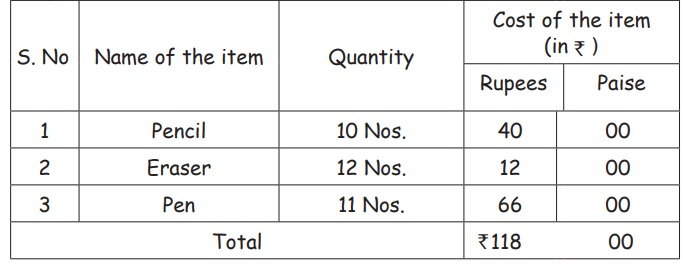Money | Term 3 Chapter 5 | 5th Maths - Expensive, inexpensive costly, cheap, affordable and luxurious | 5th Maths : Term 3 Unit 5 : Money
Chapter: 5th Maths : Term 3 Unit 5 : Money
Expensive, inexpensive costly, cheap, affordable and luxurious
To collect bills for items bought and compare costs of same
items
Situation
Raju
and Ravi got two bills of the same items from two different shops which are
given below.
Shop 1 (Raju’s Bill)

Shop 2 (Ravi’s Bill)

They have shown the above bills to the teacher
in the class. Teacher asks the students to sit in groups and discuss and
compare the cost of items. After a few minutes, the teacher asks the following
question regarding bills.
Teacher: In which shop is the cost of an eraser less? By how much?
Student: In shop 2, it is less by ₹ 3.
Teacher: What is the difference in total between shop 1 and shop 2?
![]() Student: ₹ 5.
Student: ₹ 5.
Teacher: Is the cost of a pencil high or less in shop 1 compared to
shop 2?
Student: The cost of a pencil is less in shop 1.
Teacher: What is the cost of a pen in shop 1 and shop 2? Also find
the difference between the costs?
Student: The cost of 1 pen in shop 1 is ₹5.50 and in shop 2, it is ₹ 6. The difference between the cost is 50 paise.
The teacher concludes that the cost vary from place to place depending on factors like travel, rent, wages for labour and electricity etc., used by the shopkeeper.
Activity
Observe at the vegetables shop nearby your house and find out
the cost of items sold over there. Compare it with the cost of vegetables sold
at the supermarket nearby to your house.
To
find and reason out for being expensive and inexpensive
Situation
Rani
bought 1 kg of brinjal from a vegetable vendor nearby her house. Its cost was ₹
50. Her friend Kala bought the same quantity of brinjal in a wholesale market.
Its cost was ₹ 30. What did you understand from the above situation?
From
the above situation, we come to understand that the brinjal bought by Kala is
inexpensive, but for Rani, it is expensive.
Activity
Check the cost of items
bought from the provision store nearby your house and the cost of the same item
in the supermarket. Find out which is expensive and inexpensive.
Use of vocabularies such as expensive, inexpensive costly,
cheap, affordable and luxurious
Situation 1
Ravi goes to a provision store to buy provisions for his family. He wants to buy boiled rice. He sees many brands of boiled rice and from that he selected a brand. In that particular brand, there are different types, with a range of costs. It is given below.
Type-1 = ₹ 42 per kg
Type-2 = ₹48 per kg
Type-3 = ₹ 52 per kg
Type-4 = ₹ 56 per kg
He buys Type-1 boiled rice which costs ₹ 42 per kg. Why does he choose to buy that type and not other
types? Though it is affordable for him to
buy other types also, he thinks that Type-1 is
cheaper for him.
Situation 2
Three families namely A, B and C in a
city wanted to buy a car. They had gone to a car showroom. There, they saw cars
of minimum price
and maximum price and also the imported car.
Family A selected the car of minimum price. Why
did family A select the car of minimum price? Though they had money to buy the
car of maximum price, they felt that the car of minimum price is inexpensive for them.
Family B selected the car of maximum price. Why
did family B select the car of maximum price? Though they had money to buy
other cars also, they selected the car of maximum price which is expensive.
Family C selected the imported car because they
wanted a luxurious
car.
Now, we can see the meaning of following words:
(i)
Expensive - Costing much in price.
(ii)
Inexpensive - Low cost.
(iii)
Costly - High in price.
(iv)
Cheap - Low in price.
(v)
Affordable - Reasonable price.
(vi)
Luxurious - Highly expensive.
Activity
Ask the students to go to the
market and find out the selling price of each and every vegetable
in various shops over there and make them to prepare a list of their
observations. Let them discuss about this in the classroom like which is
cheaper, costlier and affordable with their pair groups. The teacher has to
instruct the students while discussing.
Activity
Fruit seller-1, uses her bike to
sell her fruits for ₹ 150 and spends ₹ 170
for petrol. But fruit seller-2 sitting outside of an office and sells her
fruits for ₹ 250.
Make the students to sit in groups
to discuss about this situation on which is costlier and which is cheaper?
Related Topics